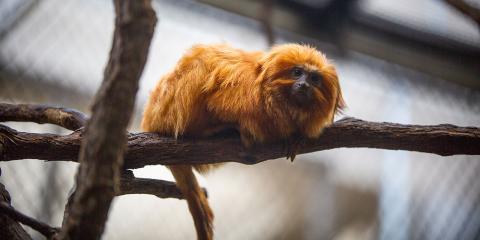News Archive
Filter By
- Abyssinian ground hornbill
- Addax
- Aldabra tortoise
- Allen's swamp monkey
- Alpaca
- American alligator
- American avocet
- American bison
- American flamingo
- American wigeon
- Andean bear
- Aquatic caecilian
- Arapaima
- Asian elephant
- Asian small-clawed otter
- Asian water dragon
- Australian snake-necked turtle
- Bald eagle
- Baltimore oriole
- Barred owl
- Bearded emperor tamarin
- Beaver
- Bennett's wallaby
- Binturong
- Black-and-white ruffed lemur
- Black-crowned night heron
- Black-footed ferret
- Black-tailed prairie dog
- Black-throated blue warbler
- Blue-billed curassow
- Blue crane
- Bobcat
- Brown pelican
- Bufflehead
- California sea lion
- Canvasback
- Cedar waxwing
- Channel catfish
- Cheetah
- Chicken
- Chinese alligator
- Chinese three-striped box turtle
- Clouded leopard
- Collared brown lemur
- Common raven
- Common yellowthroat
- Corals and sea anemones (anthozoa)
- Cow
- Crocodile monitor
- Cuban crocodile
- Dama gazelle
- Degu
- Dunlin
- Eastern indigo snake
- Eastern newt
- Eastern red-backed salamander
- Eastern screech-owl
- Eld's deer
- Electric eel
- Emperor newt
- Fennec fox
- Fishing cat
- Gaboon viper
- Geoffroy's marmoset
- Gharial
- Giant leaf-tailed gecko
- Giant panda
- Goat
- Golden-headed lion tamarin
- Golden lion tamarin
- Gray seal
- Gray wolf
- Green tree python
- Grevy's zebra
- Guam kingfisher (sihek)
- Guam rail (ko’ko’)
- Guinea pig
- Harbor seal
- Hartmann's mountain zebra
- Hawk-headed parrot
- Hellbender
- Home's hinge-back tortoise
- Hooded crane
- Iranian fat-tailed gecko
- Japanese giant salamander
- King vulture
- Komodo dragon
- Kori bustard
- Kunekune pig
- Land hermit crab
- Larger Malay mouse-deer
- Lemur leaf frog
- Lesser hedgehog tenrec
- Lesser kudu
- Lion
- Loggerhead shrike
- Long-tailed chinchilla
- Long-tailed salamander
- Maned wolf
- Meerkat
- Miniature donkey
- Naked mole-rat
- North American porcupine
- North American river otter
- Northern Luzon giant cloud rat
- Northern pintail
- Northern red salamander
- Northern snakehead fish
- Northern tree shrew
- North Island brown kiwi
- Norway rat
- Orangutan
- Orchard oriole
- Ossabaw Island hog
- Ostrich
- Ovenbird
- Pallas's cat
- Panamanian golden frog
- Patagonian mara
- Persian onager
- Philippine crocodile
- Prehensile-tailed porcupine
- Prevost's squirrel
- Przewalski's horse
- Pygmy slow loris
- Red-crowned crane
- Red-fronted lemur
- Red-rumped agouti
- Red-winged blackbird
- Red knot
- Red panda
- Red River hog
- Red ruffed lemur
- Red wolf
- Ring-tailed lemur
- Ruddy duck
- Schmidt's red-tailed monkey
- Scimitar-horned oryx
- Screaming hairy armadillo
- Semipalmated plover
- Semipalmated sandpiper
- Siamang
- Sitatunga
- Sloth bear
- Southern lesser galago
- Southern swamp sparrow
- Southern tamandua
- Spider tortoise
- Striped skunk
- Tanagers
- Tentacled snake
- Tiger
- Titi monkey
- Turkey
- Twig catfish
- Two-toed sloth
- Vietnamese mossy frog
- Virginia opossum
- Von der Decken's hornbill
- Western lowland gorilla
- White-cheeked gibbon
- White-faced saki
- White-naped crane
- White-nosed coati
- Whooping crane
Displaying 2201 - 2225 of 2362 articles.
The Scientist in the Woods: Jonathan Thompson
The Smithsonian Conservation Biology Institute has scientists all over the world, working to conserve all sorts of threatened ecosystems: grasslands in South America, jungles in Africa, cloud forests in Asia, coral reefs in the Pacific Ocean. But not all endangered ecosystems are in far-flung...
Panama Amphibian Rescue and Conservation Project
When you ponder the enormity of the situation we’re in: the biggest mass extinction of life on Earth, bigger even than the extinction that saw the dinosaurs out, up against that, any one human’s actions can seem like trying to bail the Titanic with a soup spoon. Many people are trying though. For...
National Zoo's Elderly Tiger Dies
The Smithsonian’s National Zoo is mourning the loss of its elderly male Sumatran tiger ( Panthera tigris sumatrae), Rokan, today, while celebrating his contributions to conservation during his long life. At almost 20 years of age, Rokan lived longer than the 15-year life expectancy for Sumatran...
Two Rare Crane Hatchings at the Smithsonian Mark a Victory for Science and Conservation
Two rare white-naped crane chicks hatched at the Smithsonian Conservation Biology Institute in Front Royal, Va., May 12 and 14. The hatchings of the two chicks validate the National Zoo’s continued success in breeding some of the most genetically valuable cranes in the North American White-Naped...
Poised for New Discoveries, Smithsonian's National Zoo Opens New Genetics Labs
With test tubes filled with sparkling juice in hand, Smithsonian scientists and officials toast the new genetics lab, which the Smithsonian Conservation Biology Institute officially opened today at the National Zoo in Washington, D.C. Genetics research at the Zoo will help conservationists worldwide...
Smithsonian's National Zoo Opens New Genetics Lab
The Smithsonian Conservation Biology Institute’s geneticists are ironing their lab coats and revving up their DNA sequencers for the celebration of the group’s new state-of-the-art genetics lab at the National Zoo in Washington, D.C., where researchers will look at life’s smallest building blocks in...
National Zoo Mourns Loss of Newborn Lion
Last evening, the National Zoo’s lion cub died. Lion keepers had been closely observing the cub, a male, via camera since his birth Tuesday morning. When keepers noticed the cub was not responding to its mother, they shifted the mother outdoors in order to examine the cub. A veterinary team...
In the Face of Forest Loss, Scientists Call for Accelerated Conservation
New England forests are at a turning point. For the first time in 200 years, forest cover—which peaked at 80 percent of the landscape in 2000—has begun to decline in every New England state. If sprawl and development continue at current rates, 63 percent of the landscape may be developed by 2030...
National Zoo's Lone Speke's Gazelle Turns 15 on May 12
Bati, an endangered Speke’s gazelle at the Smithsonian’s National Zoo, turns 15 years old tomorrow, May 12. He was born at the St. Louis Zoo in 1995 and is the oldest documented Speke's gazelle living in a zoo. Bati will receive an ‘herbivore’s delight’ consisting of grass, herbs, shrubs and other...
FONZ Offers an Abundance of Educational Experiences Through Its Volunteer Program
Friends of the National Zoo (FONZ) is seeking volunteers with an interest in animals and their conservation to assist with upcoming events, games, projects and keeper needs. Volunteers offer invaluable support to the Zoo—they work with staff, visitors, animals, plants, independently and in groups...
Conservation, Chefs and Cuisine to Bring Out Thousands for ZooFari 2010 at the National Zoo
Don’t miss what has become a spring tradition and one of the premier culinary events in Washington, D.C.: ZooFari! Taking place at the Smithsonian’s National Zoo on May 20 from 6:30 to 9:30 p.m., and hosted by the Friends of the National Zoo, ZooFari 2010 – “A Panda Bear Affair” – will bring...
Oryx Breeding Program Kicks Off with Birth of Female Calf; Staff Confirm Sex of Clouded Leopard Cubs
A scimitar-horned oryx has joined the ranks of endangered animals born this year at the National Zoo’s conservation center in Front Royal, Va., where scientists also recently confirmed the gender of the Zoo’s nearly 3-month-old clouded leopards.
Ambassador Names National Zoo's First Female Kiwi Chick
History was made March 30 in the Bird House at the Smithsonian’s National Zoo when its first female brown kiwi chick ( Apteryx mantelli) emerged from her shell. To mark this historic hatching, keepers bestowed the honor of naming the chick on one of her countrymen: New Zealand Ambassador to the...
Andean Bear Cubs Gear Up for Public Debut; Public Can Weigh in on Naming the New Bears
The two Andean bear cubs, Tremarctos ornatus (also known as the spectacled bear), that were born at the Smithsonian’s National Zoo in mid-January are getting ready for two big events: receiving their names May 19 and making their public debut May 22. After months of seclusion in their indoor den...
Birth of Lion Cub Expands National Zoo's Lion Pride
For the first time in more than 20 years, tiny lion paws are making a mark at the Smithsonian’s National Zoo. Early this morning 6-year-old lion Nababiep gave birth to one cub, adding another member to the lion pride the Zoo has carefully worked to build over the past year. “This is a historic...
Chaska and Bernardo Are the Names of the National Zoo's Andean Bear Cubs
One week and nearly 5,000 votes after the Smithsonian’s National Zoo opened the online polls to the public to name its male and female Andean bear cubs the Zoo has two winners: Chaska, pronounced Chas'-kuh, for the female and Bernardo for the male! Animal keepers and the embassies of Peru and...
The House Wren: Small Bird, Big Voice
One of the loudest birds that we hear in our yards is also one of the smallest. The tiny house wren weighs only 11 grams, about the same as 2 quarters, and is a mere 4 inches long.

Tracking Tamarins in Brazil
By Kenton Kerns, Small Mammal House Keeper at the National Zoo It’s February 24, 2010, and I am riding up and down Brazil 101, a major thoroughfare highway between Rio de Janeiro and other Brazilian cities to the north. It’s my 12th day in Brazil and I’ve come here to learn about golden lion tamarin...
Shipping Industry Sends Help as Project in Panama Tackles Amphibian Crisis
As a disease known as amphibian chytrid fungus continues to wipe out amphibian species worldwide, frogs in Panama are finding a safe haven in a seemingly unlikely spot—between the metal walls of shipping containers once used to transport ice cream, strawberries, coffee beans, flowers and...
The Votes Are in: National Zoo's New Octopus Gets a Name
Two weeks and 7,050 votes after the Smithsonian’s National Zoo opened the online polls to the public to name its new giant Pacific octopus ( Enteroctopus dofleini), one choice has emerged as the clear victor: Octavius. “Octavius the Octopus” is more than just a pretty, alliterative name. The prefix...
National Zoo's Giant Panda Is Not Pregnant 4/27/2010
Following a final ultrasound and hormone analysis, staff at the Smithsonian’s National Zoo confirmed late yesterday (Tuesday, April 27) that female giant panda Mei Xiang (may-SHONG) is not pregnant but was experiencing a pseudo, or false, pregnancy during the past several months. National Zoo...
Female Giant Panda's Hormones on the Rise 4/27/2010
Scientists at the Smithsonian’s National Zoo detected a secondary rise in urinary progestagen levels in the Zoo’s female giant panda Mei Xiang (may-SHONG) March 30. This hormone rise indicates that it should be 40 to 50 days before Mei Xiang either gives birth to a cub or comes to the end of a...
Around-the-Clock Pregnancy Watch Begins of National Zoo's Female Giant Panda
A 24-hour pregnancy watch of the Smithsonian’s National Zoo’s female giant panda Mei Xiang (may-SHONG) is slated to begin today at 4 p.m. A corps of more than 40 Friends of the National Zoo volunteers and animal care staff will closely monitor the panda for maternal behaviors through keeper...
Bird Friendly Organic Coffee For Sale in Smithsonian Museum Cafes
Shade-grown, Bird Friendly coffee is now available in five museum locations at the Smithsonian.
Catching Koris in Kenya
By Stephen Schulze, Keeper at the National Zoo’s Small Mammal House Bustard populations across the world are in decline, including those of kori bustards, the heaviest of all flighted species of bird. This past autumn, I was privileged to join a National Zoo team that travelled to Kenya to continue...
